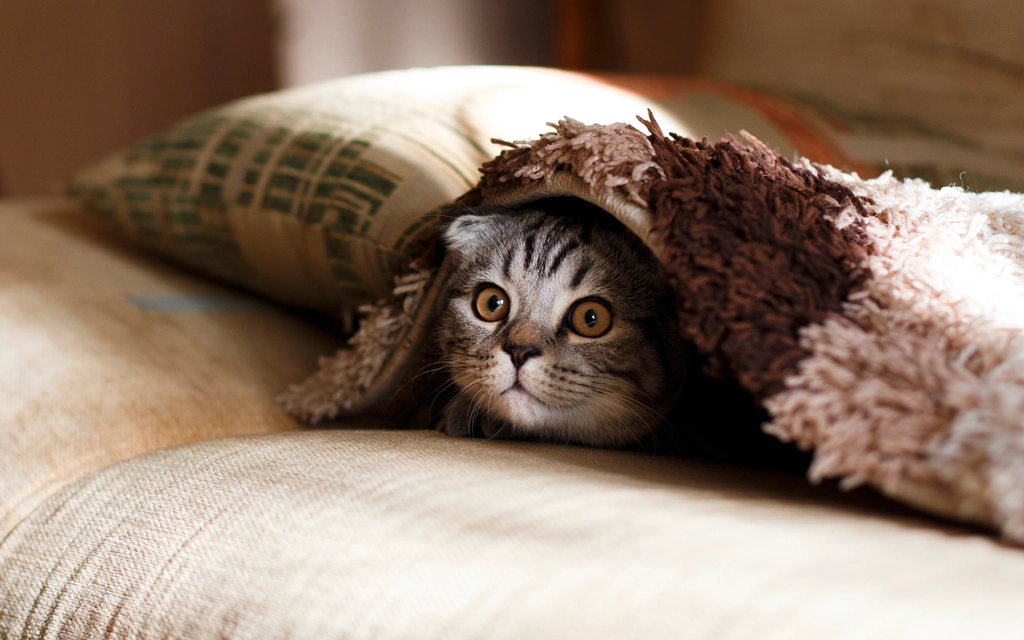Cats are enigmatic creatures, often leaving us puzzled by their behaviors and expressions. While they are generally more independent than their canine counterparts, cats can still experience anxiety and stress. However, instead of vocalizing their discomfort, they communicate their feelings in subtler ways. Understanding these behaviors is crucial for cat owners, as it can help them provide a more comforting and stress-free environment for their feline friends. Dive into these nine signs of anxiety in cats and learn how to interpret what your furry companion might be trying to tell you.
1. Excessive Grooming
One of the most common signs that a cat is feeling anxious is excessive grooming. Cats are naturally meticulous creatures, spending a good portion of their day cleaning themselves. However, when this behavior becomes obsessive, it could indicate anxiety. Cats might groom a specific area on their body repeatedly, leading to bald patches or skin irritation. Imagine your cat as a person biting their nails when stressed; it’s a similar coping mechanism. Keeping an eye on grooming patterns can help detect any underlying stressors your cat might be experiencing.
2. Hiding More Than Usual

While it’s normal for cats to seek solitude occasionally, excessive hiding can be a red flag. If your cat is spending more time than usual under the bed or in the closet, it might be feeling anxious. This behavior is akin to how humans might retreat to a quiet room when overwhelmed. Cats hide to feel safe and away from perceived threats. If you notice this behavior, try to identify any recent changes in their environment that might be causing stress, such as a new pet or loud noises.
3. Unusual Aggression
Aggression can be a surprising response from an anxious cat. If your usually affectionate feline suddenly becomes aggressive, it might be trying to communicate its discomfort. This aggression can manifest in the form of hissing, swatting, or even biting. It’s essential to approach an aggressive cat with caution and try to identify the root cause of its anxiety. Remember, aggression is often a defense mechanism, and your cat is likely feeling threatened or scared.
4. Loss of Appetite
A sudden change in eating habits can be another indicator of anxiety in cats. If your cat is ignoring its meals or eating significantly less than usual, it might be experiencing stress. Just like humans might lose their appetite when anxious, cats can react similarly. This behavior can lead to weight loss and other health issues if not addressed promptly. Ensure your cat’s feeding area is quiet and free from disturbances to help alleviate its anxiety.
5. Litter Box Avoidance
Cats are generally clean animals that prefer using their litter box. However, if your cat starts avoiding it, it could be a sign of anxiety. This behavior might be due to changes in the household, such as a new pet or unfamiliar visitors. Cats might associate the litter box with stress and choose to eliminate elsewhere. Make sure the litter box is clean and in a quiet area to encourage your cat to use it again.
6. Increased Vocalization
While this article focuses on non-meowing signs, it’s worth noting that some cats might still use their voice in other ways when anxious. This can include increased yowling or whining, particularly at night. It’s as if your cat is trying to vocalize its worries in a language it hopes you understand. Pay attention to these vocal cues and try to identify any triggers that might be causing your cat distress.
7. Changes in Sleep Patterns
Cats are known for their love of sleep, often snoozing for up to 16 hours a day. However, anxiety can disrupt their usual sleep patterns. An anxious cat might sleep more than usual as a way to escape from stress or, conversely, have trouble settling down. This change could be likened to how humans might experience insomnia or oversleeping when anxious. Monitoring your cat’s sleep habits can provide valuable insights into its emotional well-being.
8. Destructive Behavior
Another sign of anxiety in cats is destructive behavior. Cats that are feeling anxious might start scratching furniture, knocking over items, or tearing up paper. This behavior is similar to a stress-relief activity, helping them release pent-up energy. It’s crucial to provide your cat with appropriate outlets for this energy, such as scratching posts or interactive toys, to prevent damage to your home and reduce their anxiety.
9. Dilated Pupils and Ear Position
Physical cues such as dilated pupils and changes in ear position can also indicate anxiety. When a cat is anxious, its pupils might become enlarged, and its ears might flatten against its head. These are instinctive responses to perceived threats, preparing the cat for potential action. Observing these subtle changes can help you better understand your cat’s mood and respond appropriately to calm its nerves.
Understanding these signs of anxiety in cats is the first step towards helping them feel more secure and comfortable. By recognizing these behaviors and addressing the underlying causes, you can create a more harmonious environment for your beloved feline companion.

Linnea is a born and bred Swede but spends as much time as possible in Cape Town, South Africa. This is mainly due to Cape Town’s extraordinary scenery, wildlife, and atmosphere (in other words, because Cape Town is heaven on earth.) That being said, Sweden’s majestic forests forever hold a special place in her heart. Linnea spends as much time as she can close to the ocean collecting sea shells or in the park admiring puppies.






